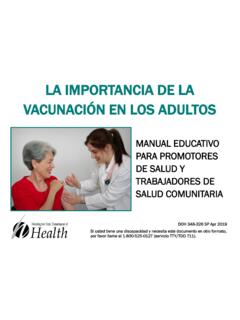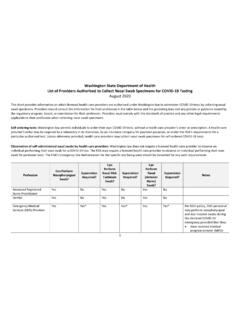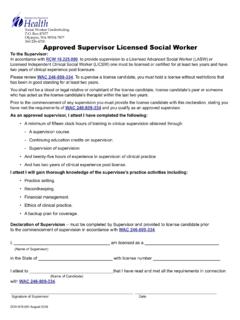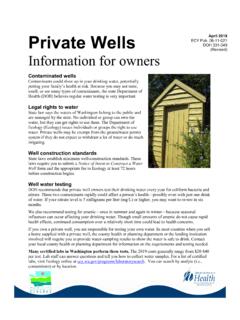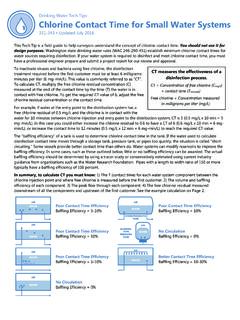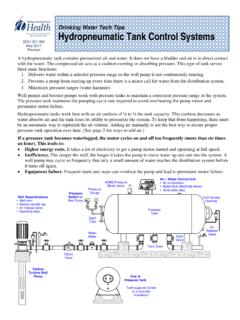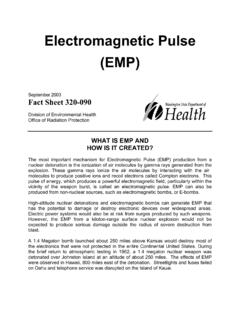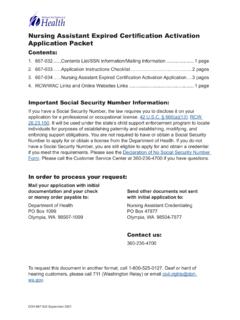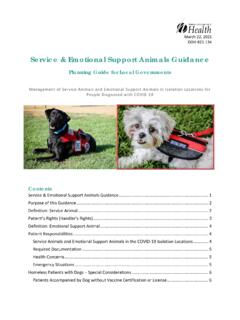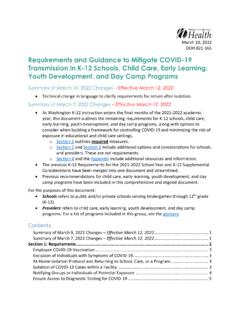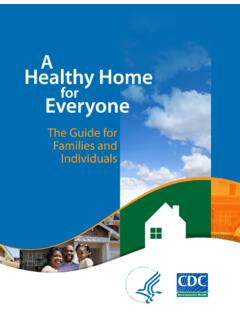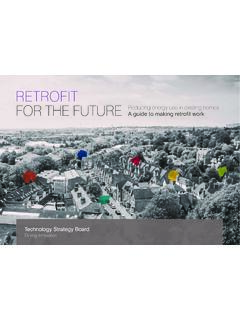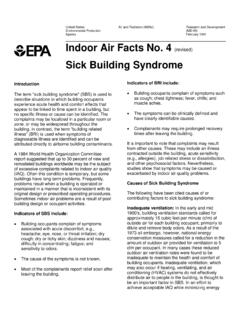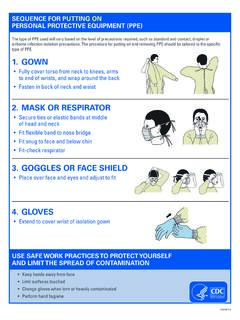Transcription of Safe Cleaning and Disinfection Guidance for Public Spaces
1 Page 1 of 4 Safely Cleaning and Disinfecting Public Spaces This Guidance describes safe Cleaning and Disinfection practices to ensure cleanliness and safety for businesses, parks, and other Public Spaces . To control the spread of illnesses, everyone should follow these important preventive measures to protect others and themselves: stay home when sick, wash your hands often, and do not touch your face. You can also reduce the risk of exposure by Cleaning and disinfecting workplaces, Public places, and homes safely. Personal Hygiene Wash hands frequently with soap and water for at least 20 seconds. Always wash your hands after going to the bathroom ; before eating; after coughing, sneezing, blowing your nose, or touching animals; and when they are visibly dirty. Provide plain fragrance-free and dye-free liquid foaming soap. Fragrances irritate about a third of people. Don t use antimicrobial soaps. They aren t generally effective, aren t necessary, and aren t good for human health or the environment.
2 If soap and water aren t available, use a generous amount of fragrance-free and dye-free hand sanitizer with at least 60 percent alcohol. Wash your hands as soon as you can. Cleaning and Disinfection Cleaning : Uses soap or detergent to remove dirt and impurities, including germs, from surfaces. Cleaning alone does not kill germs, but thorough Cleaning will significantly decrease their numbers and lower the risk of spreading infection. Sanitizing: Reduces germs on surfaces to safe levels. Disinfecting: Kills germs on surfaces. Establish a schedule for Cleaning and disinfecting frequently touched surfaces, service counters, bathrooms, and athletic areas based on their use. Commercial kitchens, medical facilities, and childcare facilities need to follow their specific regulations for appropriate Cleaning , sanitizing, and Disinfection . How to Clean and Disinfect Sanitizers and disinfectants don t work if there s organic matter or dirt on the surface.
3 Clean with soap, water, and a microfiber cloth to remove most microorganisms. Consider using green cleaners with third-party certification (Green Seal, EPA Fragrance-Free Safer Choice), which are better for health and indoor air quality. Launder or vacuum soft and porous surfaces. These items are difficult to disinfect and don t usually need it. If they are frequently touched, consider removing or replacing them with easily cleanable items. Page 2 of 4 Sanitizers and disinfectants must be EPA-registered antimicrobial products. If they aren t EPA registered, they aren t appropriate. All facilities must have a Safety Data Sheet (SDS) for each chemical used. When possible, chose safer fragrance-free disinfectants and sanitizers. Hydrogen peroxide or alcohol-based products are safer for human health and don t cause asthma. For Guidance on choosing safer disinfectants: Design for the Environment Certification - EPA Cleaning for Asthma- safe Schools - California Department of Public Health Safer Cleaning , Sanitizing, and Disinfecting Strategies to Prevent Infection Transmission - University of Washington (PDF) When EPA-approved disinfectants aren t available, other disinfectants can be used: 70 percent isopropyl alcohol.
4 1/3 cup of 6 percent bleach added to 1 gallon of water with a 1-minute wet contact time. Bleach is not a cleaner and bleach solutions for sanitizing and disinfecting should only be used on cleaned and rinsed surfaces. When mixing bleach from concentrate, an emergency eyewash and good ventilation are required. Do not mix bleach or other Cleaning and Disinfection products together. This can cause very dangerous fumes. Quaternary ammonia products and bleach can cause asthma. Apply Disinfectants to High Touch Surfaces Always read the product label before using the product and follow its instructions, including application method. It is a violation of law to use a registered product in a manner inconsistent with its label. Applying products using a different method than the label calls for, could affect the efficacy and safety of the product. Use the proper concentration of disinfectant. The disinfectant must stay wet on the surface for the time the label requires to kill organisms.
5 Follow the product label s hazard warnings and instructions for personal protective equipment (PPE) such as gloves, eye protection, and ventilation . Use disinfectants in a well-ventilated space . As much as possible, disinfect surfaces when workers and visitors are not present. Thoroughly air out the area before occupants return. Do not use fogging, fumigation, or wide-area spraying to control the spread of germs. These methods are not effective, do not clean contaminated surfaces, and are hazardous to human health. Page 3 of 4 Guide for Specific Areas and Surfaces - Frequency Depends on Use Clean and disinfect elevator buttons, door handles, push bars, automatic door buttons, and other high-touch surfaces at least daily. Shared Restrooms Thoroughly clean and disinfect restrooms, including all frequently touched areas such as door handles, flush buttons or levers, counters, sink and shower handles, and light switches.
6 Keep restrooms stocked with soap and paper towels. At remote restrooms that cannot be cleaned and disinfected regularly, post signs to that effect and remind people to wash their hands thoroughly. Ensure exhaust ventilation systems are running continuously and as much fresh air is coming in as possible. If safe , keep windows open to increase ventilation . Public Drinking Fountains and Bottle Fillers Public drinking water supplies are safe . Clean and disinfect surfaces and buttons at least daily. Consider posting signage that includes: Do not place your mouth on the spout of the fountain or allow your water bottle to contact the nozzle when refilling. Allow water to flow for 10 seconds to allow clean water to come through before drinking. Keyboards and Other Sensitive Electronics Use alcohol wipes or spray 70 percent isopropyl alcohol into a cloth to wipe electronics. Use a separate area of the cloth for each device.
7 Wash and dry cloths after use. Wash hands before and after use of electronics and do not touch your face while using. Do not share items if you do not need to. Athletic Equipment Thoroughly clean and disinfect all surfaces that may contact skin at least daily and between use by different people. Surfaces (including mats) must be intact, without rips and tears, to be cleanable. Have separate Cleaning mops and buckets for athletic areas. Buses Maximize ventilation on the bus by keeping at least 2 front and 2 rear windows open a few inches. Leave windows open to air out the bus after runs. Clean seats and rails with soap, water, and microfiber cloths daily. Disinfect after Cleaning if there have been body fluids, such as blood, vomit, and feces. Do not fog or mist the bus with disinfectant. Playgrounds Do not spray disinfectants on outdoor playgrounds. Clean if needed. Require children to wash their hands with soap and water when they come inside or prior to eating or drinking.
8 Page 4 of 4 Children s Toys Wash soft or porous children s toys in the highest water temperature appropriate for the item and dry completely. Clean hard plastic toys thoroughly. In general, thorough Cleaning with soap and water is all that is necessary. Disinfectants can be harmful to children, especially if small children put them in their mouths. Select chemicals carefully and consider: Is it corrosive? Is it a skin, eye, or respiratory irritant? Does it leave a residue? Is it toxic by skin absorption, ingestion, or inhalation? Soft (porous) Surfaces Surfaces such as carpeted floors, rugs, and drapes require only routine Cleaning appropriate for the surface. Follow the manufacturer s instructions to launder these items. Use the warmest water possible and dry completely. To clean carpets, use truck-mounted hot water/steam extraction. Spot treat as needed first. Use the minimum amount necessary of low-odor and low-sudsing carpet shampoo.
9 Thoroughly remove cleaner and dirt. The water should run clean. Carpet should dry thoroughly within 24 to 48 hours to prevent mold and bacterial growth. DOH 333-299 December 2022 To request this document in another format, call 1-800-525-0127. Deaf or hard of hearing customers, please call 711 (Washington Relay) or email
